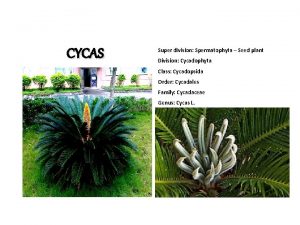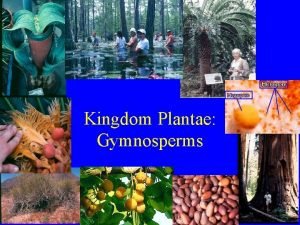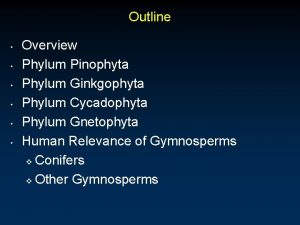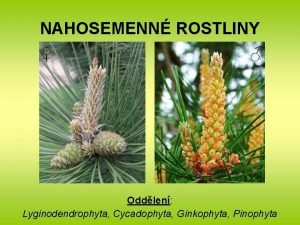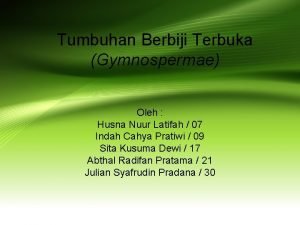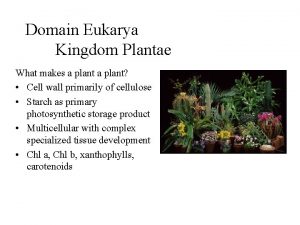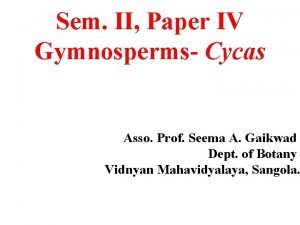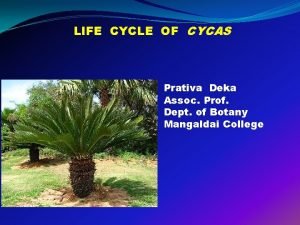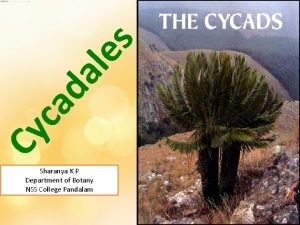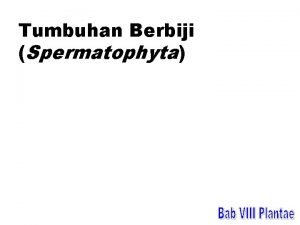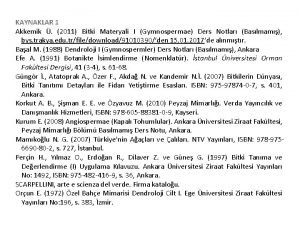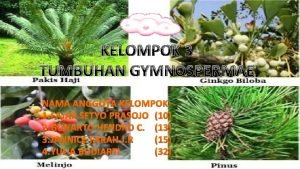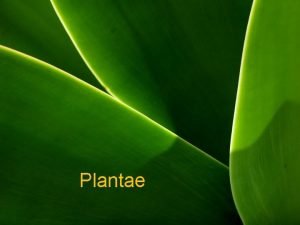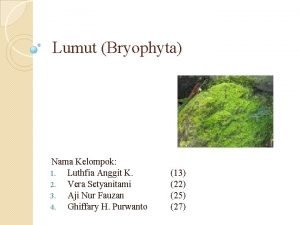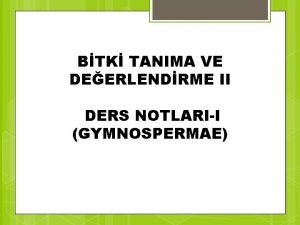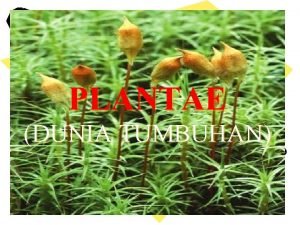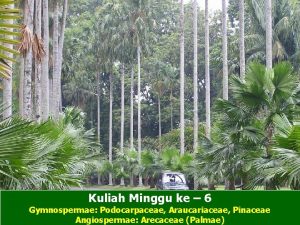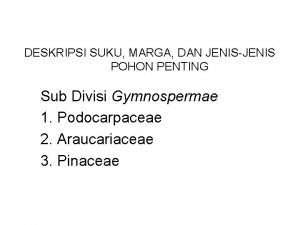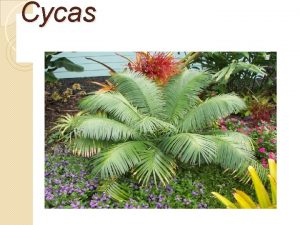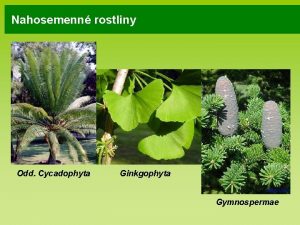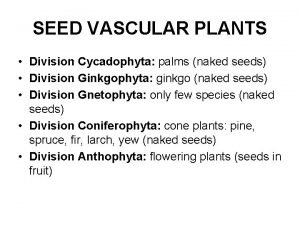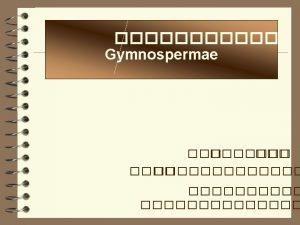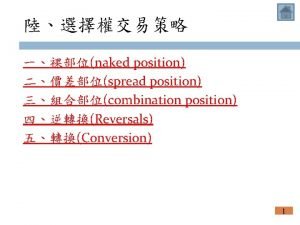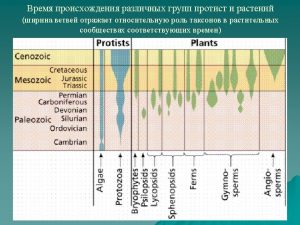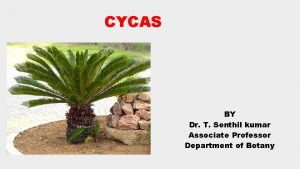PRESENTATION ON CYCAS Position GYMNOSPERMAE Division CYCADOPHYTA Class

























- Slides: 25

PRESENTATION ON CYCAS…

Position �GYMNOSPERMAE �Division: CYCADOPHYTA �Class: CYCADOPSIDA �Order: CYCADALES �Family: CYCADACEAE �Genus: CYCAS (Greek word Kycas = Cocopalm)

Distribution & Occurrence �Includes 20 Species. �Occurs wild or cultivated in tropical and sub- tropical regions. � South of Eastern Hemisphere � e. g. S. Japan, India, China, N. Australia, E. Coasts of Africa, Myanmar, Bangladesh, Mauritius, Nepal, etc. � 6 species Indian – 4 wild & 2 cultivated. � C circinalis, rumphii, pectinata & beddomei � C. revoluta & C. siamensis

Body � Plants are low and palm-like, height 4 -8 feet. � Tallest species, C. media – upto 20 feet high. � Stem unbranched, columnar and covered with persistent leaf bases. � Leaf segment remains circinnately involute within the bud – leaves dimorphic. � Female reproductive structures – the megasporophylls are not aggregated in cones. � Ovules (2 or more) borne on the lower margins in ascending order.

Morphology � Stem – Cycas plant shows tuberous stem when young, becoming columnar and unbranched later. � Leaf – Shoot apex is protected by a rosette of brown scale leaves. � Plant grows very slowly adding a new crown of leaves every 1 or 2 years, alternating with crown of scale leaves.

Morphology �The pinnately compound megaphyllous leaves have 80 -100 pairs of leaflets arranged on the rachis. �Circinnate ptyxis of young leaves is a fern like character. �Leaf base is rhomboidal in shape and attaches the leaf transversely to the stem. �The leaflets are thick , leathery in texture, ovate or lanceolate in shape & photosynthetic in function.

External Morphology � Scale leaves are very small, rough and dry, triangular in shape and brown in colour, thickly coated in ramenta. � Root is of two types-normal and coralloid. � Normal tap-roots grow from the radicle deep inside the soil giving out lateral branches. � Some of the lateral roots grow apogeotropically towards the surface of soil and branch dichotomously. � These roots are short, thick and swollen at the tips.

Morphology � The much branched mass appears like a coral on the soil surface hence called coralloid roots. � Do not bear root caps. � The cluster has lenticel like apertures. � Become infested by N 2 fixed bluegreen algae (cyanobacteria); bacteria & diatoms e. g. Nostoc punctiforme, Anabaena cycadacaerum. � Symbiotic relationship thus established.

Anatomy - Root � Young root shows typical structure like that of a dicotyledonous root. � Outermost layer, epiblema, encloses the parenchymatous cortex interspersed with tannin cells and mucilage canals. � Endodermis with casparian thickenings. � Pericycle is multilayered with thin cells having starch grains. � Vascular tissue within is typically radial. � Roots usually diarch to tetraarch, rarely polyarch. � Vessels absent in vascular tissue. � Pith reduced or absent.

Anatomy – Root Coralloid Roots. . �Has additional algal zone in the cortex. �Cells of algal zone palisade like and form the middle cortex.

Anatomy – Stem �Show irregular outline due to the presence of leaf bases, therefore epidermis is not a continuous layer. �Broad cortex is traversed by simple and girdle leaf traces. �Numerous mucilage canals, starch grains also present. �Narrow zone of vascular tissue having open, endarch. vascular bundles arranged in a ring and separated from each other by wide medullary rays. Pith is large, parenchymatous having mucilage canals and starch grains.

Anatomy – Rachis �Woody and thick. �Hypodermis sclerenchymatous. �Characteristic feature is omega shaped (Ω) outline of the numerous vascular bundles. �Each bundle has sclerenchymatous bundle sheath and is open, collateral.

Anatomy – Leaflet � Leaflet is thickly cutinized and leathery. � Sunken stomata and thickened hypodermis present. � Well developed palisade layer in mesophyll. � Between the palisade and lower mesophyll layers, there are transversely running long colourless cells in 3 -4 layers extending from mid-rib to near leaf margin. � These constitute the transfusion tissue. � Mid-rib bundle consists of a broad triangular centripetal xylem and two small patches of centrifugal xylem – thus dipoxylic. � Phloem abaxially placed.

Vegetative �Vegetative reproduction is by means of bulbils. �Develop in crevices of scale leaves and leaf bases at the basal part of an old stem. �Produces new plant on detachment.

Reproduction – Sexual The Malaysian cycad Cycas circinalis. Left photo shows the "cone" of a female plant with modified leaves (sporophylls) bearing small ovules along their margins. Center photo shows a female plant with clusters of mature seeds atached to the sporophylls. Right photo shows the erect, pollenbearing cone (strobilus) of a male plant. The individual scales (sprophylls) of the cone bear clusters of sproangia.

Sexual �Strictly dioecious plant. �Male plants are rare. �Male strobilus or cone borne singly at the apex of the trunk. �Apical shoot apex utilized in the development of male cone, hence branching sympodial. �Cone shortly stalked & large (up to 50 cm length or more).

Sexual �Numerous micro-sporophylls spirally arranged around the central axis. �Each microsporophyll is narrow below and broad above terminating into projection – the apoplysis. �Microsporangia confined to abaxial (lower) surface. �Usually present in sori – each with 2 -6 sporangia. �They contain a large number of haploid microspores (pollen grains).

Female Reproductive Structures �Female plant do not produce definite cones. �A whorl of spirally arranged megasporophylls arise around the short apex. �Each megasporophyll resembles the foliage leaf and approximately 10 -23 cm. long �Lower petiolar part bears the naked ovules on the margins.

Ovule Structure � Largest ovule (6 cms. x 4 cms. ) seen in C. circinalis. � Ovules are orthotropous, sessile, ovoid or spherical in shape and unitegmic. � The thick integument is differentiated in three layersouter and inner fleshy layers, middle stony. � The integument remains fused inside with nucellar tissue except at the position where it forms the micropylar opening. � Ovule is well supplied with vascular bundles.

Megasporangium �The megaspore develops in the nucellus by meiotic division and goes on to form female gametophyte tissue. � 2 -3 archegonia are formed in this haploid tissue which is food laden. �Egg cell in the venter of archegonia, undergoes fertilization by the motile spermatozoid forming diploid zygote.

Pollination - Development of male gametophyte after pollination �The pollen grains are carried by wind (Anemophily) and caught by pollination drop secreted by ovule. Pollination is direct. �The pollination drop is dehydrated and the pollen grains are sucked into the pollen chamber. �Pollen grains take rest for some time in the pollen chamber.

Pollination - Development of male gametophyte after pollination � During the germination of pollen grain the exine is ruptured and the inner intine comes out in the form a tube like structure known as pollen tube. � At this time the generative cell divides and forms a larger, upper body cell and smaller, lower stalk cell. � The pollen tube acts as haustorium to absorb food materials from the nucellus besides as sperm carrier. � The body cell divides and forms two naked, top shaped, motile, multiciliated antherozoids. The cilia are in 4 – 5 spirals. � The male gametes of Cycas are 180 – 210 μ in size and largest in the plant kingdom. � The pollen tube apex is ruptured and the male gametes are released into the archegonial chamber. � Presence of multiciliated male gametes is the fern character shown by Cycas male gametophyte.

Young Sporophyte – Embryo �Embryo development is meroblastic. �Proembryo shows upper haustorial part, middle elongating suspensors and the basal meristematic embryonal region.

Seed �A mature embryo is straight and has a short hypocotyl. �Embryonal axis has plumule at one end and radicle at the other. �Radicle is covered by coleorhiza. �Number of cotyledons maybe 2 -3. . �Nucellus is completely absorbed in the seed. �Mature seed is large 2. 5– 5 cm wide and usually orange or red in colour. . �Germination is hypogeal type.

u o y k n Tha
 Division cycadophyta
Division cycadophyta Cycas revoluta male cone
Cycas revoluta male cone Second position echappe
Second position echappe Cycadophyta phylum
Cycadophyta phylum Mikrostrobilus
Mikrostrobilus Phylum gnetophyta
Phylum gnetophyta Modřín opadavý
Modřín opadavý Memiliki strobilus
Memiliki strobilus Domain of plantae
Domain of plantae Xerophytic adaptation of cycas leaflet
Xerophytic adaptation of cycas leaflet Life cycle of cycads
Life cycle of cycads Mikrostrobilus
Mikrostrobilus Tumbuhan dikotil
Tumbuhan dikotil Gymnospermae ders notları
Gymnospermae ders notları Kelompok gymnospermae
Kelompok gymnospermae Akar tunggang
Akar tunggang Peta konsep tumbuhan lumut
Peta konsep tumbuhan lumut Kelompok gymnospermae
Kelompok gymnospermae Gymnospermae ders notları
Gymnospermae ders notları Akar semanggi
Akar semanggi Pinang gymnospermae
Pinang gymnospermae Angiospermae
Angiospermae Burseracea
Burseracea Long division and short division
Long division and short division F(3)
F(3) Whats a dividend in math
Whats a dividend in math
